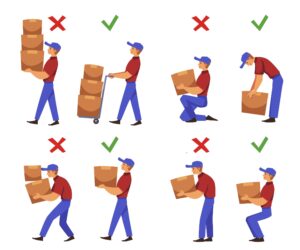This guide will provide information on workplace manual handling compensation claims. According to the Health and Safety Executive (HSE) workplace injury statistics, lifting, handling, and carrying made up 18% of all non-fatal injuries in the workplace. However, not all injuries sustained at work will lead to a claim. There are certain requirements that must be met in order to put forward a personal injury claim for an accident at work. We will discuss these in more detail throughout our guide.
Additionally, we will explore the different stages of the claims process, including the evidence you can gather to support your case and the benefits of seeking legal advice from a No Win No Fee solicitor.
Furthermore, the guide will discuss the settlement you could be awarded following a successful personal injury claim and how your potential payout can be calculated.
For more information on starting a claim following a manual handling accident at work, please get in touch with an advisor. They can provide further guidance relating to your potential claim. To get in touch:
- Contact us by completing our online form.
- Telephone 0161 696 9685
- Talk to an advisor using the live chat feature below.
Select A Section
- Who Could Make Workplace Manual Handling Compensation Claims?
- Examples Of Manual Handling Accidents
- Proving Liability For Workplace Manual Handling Compensation Claims
- Examples Of Manual Handling Compensation Payouts
- Funding A Solicitor With A No Win No Fee Agreement
- Read More About Manual Handling Accidents And Injuries
Who Could Make Workplace Manual Handling Compensation Claims?
In order to establish whether you can make a personal injury claim for a manual handling injury, you must demonstrate that negligence has occurred. This involves satisfying these criteria:
- Firstly, you were owed a duty of care.
- Secondly, there was a breach of duty.
- Thirdly, this breach caused your injuries.
Employers owe their employees a duty of care under the Health and Safety at Work etc. Act 1974 (HASAWA). This means they have to take reasonable steps to ensure the workplace is safe to prevent injuries to employees. Section 2 of HASAWA provides more details on the steps they need to take. It states they need to provide training to employees so they are able to carry out their work-related duties safely. A failure to do so could see you injured while carrying out manual handling tasks.
In addition to proving negligence, you also need to start your claim within the relevant limitation period set out in the Limitation Act 1980. This is generally three years from the accident date, but exceptions can be made in certain circumstances.
For more information on when you could be eligible to make a manual handling claim and how long you have to seek compensation, get in touch on the number above.
Examples Of Manual Handling Accidents
Below, we have provided some examples of how manual handling accidents and injuries could occur:
- Improper lifting techniques due to the lack of manual handling training may result in back injury.
- Lifting equipment isn’t provided despite a risk assessment showing it was necessary. As a result, an employee sustains a neck injury and shoulder injury.
- An employee lifts a heavier weight than they should for their height causing neck and back sprains.
What Should Employers Do To Prevent Accidents When Manual Handling?
The Manual Handling Operations Regulations 1992 states that employers must avoid manual handling activities that pose a risk of injury to employees, so far as is reasonably practicable for them to do so. Where they cannot avoid these tasks, they need to carry out risk assessments so that they can identify, manage and reduce any risks posed.
Some examples of what employers can do to reduce the risk of injury are:
- Change work routine to avoid excessive work rates.
- Make the load smaller, lighter, and easier to grasp.
- Make modifications to reduce carrying distances and any unnatural carrying positions.
- Ensure the people lifting have been trained to lift as safely as possible.
Failure to do so could lead to you sustaining harm while performing a manual handling task. To find out when you could be eligible to seek personal injury compensation following an accident at work, get in touch. An advisor can discuss workplace manual handling compensation claims in more detail.
Proving Liability For Workplace Manual Handling Compensation Claims
Evidence can help to prove liability in a personal injury claim. It can demonstrate employer negligence and provide details on the ways your injuries have impacted your life physically, psychologically, and financially. Examples of the evidence you could gather to support your case include:
- CCTV footage of the accident.
- Medical records.
- A diary containing details of your injuries, the symptoms you experienced, and any treatment you received.
- Contact details of witnesses.
- A copy of the incident report from the workplace accident book.
- Receipts, payslips, travel tickets, and invoices to help prove any financial losses.
One of the services a solicitor from our panel could offer is helping you gather evidence and build your claim. They can also ensure your case is presented in full within the relevant time limit. You can enquire more about the services they offer by getting in touch on the number above.
Examples Of Manual Handling Compensation Payouts
Compensation for a successful personal injury claim can be awarded from up to two heads of claim. General damages account for the pain and suffering caused by your injuries.
Below is a table of guideline compensation brackets taken from the Judicial College Guidelines (JCG), a tool legal professionals can use to value help them value injuries.
Compensation Table
Injury Value Notes
Severe Back Injuries (iii) £38,780 to £69,730 Soft tissue injuries that cause chronic conditions. There has been treatment given but disabilities, such as ongoing pain and discomfort, persist.
Moderate Back Injuries (i) £27,760 to £38,780 Damage to an intervertebral disc alongside irritation of the nerve roots and reduced mobility.
Moderate Neck Injuries (ii) £13,740 to £24,990
Injuries that have accelerated or exacerbated a pre-existing condition over a prolonged period.
Moderate Neck Injuries (iii) £7,890 to £13,740
Moderate soft tissue injuries with a fairly protracted period of recovery.
Severe Shoulder Injuries £19,200 to £48,030 Neck injuries involving brachial plexus damage.
Less Severe Arm Injuries £19,200 to £39,170 A substantial degree of recovery from significant disabilities. This recovery will have either already taken place or will be expected to occur.
Significant Wrist Injuries £24,500 to £39,170 Disability of a permanent and significant nature is caused but some useful movement remains.
Less Severe Wrist Injuries £12,590 to £24,500 Injuries result in a permanent disability, such as a degree of ongoing pain and stiffness, despite being less severe.
Less Severe Elbow Injuries £15,650 to £32,010 Impairment of function but no surgery or significant disability.
Moderate or Minor Elbow Injuries Up to £12,590 Injuries such as simple fractures and tennis elbow where no permanent damage or impairment of function has been caused.
Please note these figures are guidelines.
Are There Other Forms Of Compensation Available?
The other head of claim is known as special damages. This accounts for the past and future financial losses caused by injuries. Some examples of the costs you might be able to claim back under special damages include:
- Travel expenses.
- Medical costs.
- Loss of earnings.
As mentioned, evidence can help to prove these losses so you should keep documentation of any money spent as a result of your injuries.
For an accurate estimate of how much your potential settlement could be worth, get in touch on the number above. Our advisors have experience in providing free valuations of workplace manual handling compensation claims.
Funding A Solicitor With A No Win No Fee Agreement
The solicitors from our panel can offer their services under a No Win No Fee agreement. Whilst there are many types, they tend to offer contracts known as a Conditional Fee Agreement. This usually means there will be no upfront cost to start a claim, and you will not be charged for your solicitor’s services whilst the claim is in process.
Additionally, you will be charged a percentage of your compensation if your claim is successful; this is known as a success fee. However, the percentage solicitors can take is legally capped by The Conditional Fee Agreements Order 2013, so you can’t be overcharged.
For more information on working with a solicitor from our panel on this basis, please get in touch with an advisor. They can assess your case and if you have the basis of a valid claim that has a chance of being successful, they could connect you with a No Win No Fee solicitor. To find out more:
- Contact us by completing our online form.
- Telephone 0161 696 9685
- Talk to an advisor using the live chat feature below.
Read More About Manual Handling Accidents And Injuries
For more of our guides:
- How to claim for a back injury at work from lifting
- How to claim for an accident with a pallet truck
- I had an accident at work – Could I claim after leaving the company?
For more external resources:
- GOV.UK – Request CCTV footage of yourself.
- NHS – How to get your medical records.
- HSE – Accident book.
Thank you for reading our guide on workplace manual handling compensation claims. If you have any other questions, please get in touch with an advisor via the contact details above.
Written by MWH
Edited by MMI


